|
In this part of the site we're going to talk about what probably was one the most important (if not the most) videogames console. This console was the successor of the Playstation One and is probably the most famous, best selling and popular videogames console. It got the sequels to METAL GEAR SOLID, FINAL FANTASY series, SPYRO THE DRAGON, PERSONA series, SUIKODEN or CRASH BANDICOOT series and got the first appearances of now classic characters like JAK & DAXTER or RATCHET & CLANK, it got awesome new releases like GOD OF WAR series, SHADOW HEARTS, SHADOW OF THE COLOSSUS, ICO, etc. Most of this information is taken from WIKIPEDIA. The PlayStation 2 (officially abbreviated PS2) is a sixth-generation video game console manufactured by Sony as part of the PlayStation series. Its development was announced in March 1999 and it was first released on March 4, 2000, in Japan. Its primary competitors were Sega's Dreamcast, Microsoft's Xbox, and Nintendo's GameCube. The PS2 is the best-selling console of all time, having reached over 150 million units sold as of January 31, 2011.This milestone was reached 10 years and 11 months after the system was released in Japan on March 4, 2000. Further, Sony said it had 10,828 titles available for the system and that 1.52 billion PS2 titles had been sold since launch. In late 2009, with developers creating new games and the console still selling steadily a decade after its original release, Sony stated that the life cycle of the PlayStation 2 will continue until demand ceases. The console was succeeded by the PlayStation 3 in 2006. A - HISTORY: Directly after its release, it was difficult to find PS2 units on retailer shelves[10] due to manufacturing delays. Another option was purchasing the console online through auction websites such as eBay, where people paid over one thousand dollars for a PS2. The PS2 initially sold well partly on the basis of the strength of the PlayStation brand and the console's backward compatibility, selling over 980,000 units in Japan by March 5, 2000, one day after launch. This allowed the PS2 to tap the large install base established by the PlayStation — another major selling point over the competition. Later, Sony added new development kits for game developers and more PS2 units for consumers. Many analysts predicted a close three-way matchup between the PS2 and competitors Microsoft's Xbox and the Nintendo GameCube (GameCube being the cheapest of the three consoles and had an open market of games); however, the release of several blockbuster games during the 2001 holiday season maintained sales momentum and held off the PS2's rivals. Although Sony, unlike Sega with its Dreamcast, placed little emphasis on online gaming during its first few years, that changed upon the launch of the online-capable Xbox. Sony released the PlayStation Network Adapter in late 2002 to compete with Microsoft, with several online first–party titles released alongside it, such as SOCOM: U.S. Navy SEALs to demonstrate its active support for Internet play.[citation needed] Sony also advertised heavily, and its online model had the support of Electronic Arts (EA). Although Sony and Nintendo both started out late, and although both followed a decentralized model of online gaming where the responsibility is up to the developer to provide the servers, Sony's attempt made online gaming a major selling point of the PS2. In September 2004, in time for the launch of Grand Theft Auto: San Andreas, Sony revealed a new, slimmer PS2. In preparation for the launch of the new models (SCPH-70000-90000), Sony stopped making the older models (SCPH-30000-50000) to let the distribution channel empty its stock of the units. After an apparent manufacturing issue—Sony reportedly underestimated demand—caused some initial slowdown in producing the new unit caused in part by shortages between the time the old units were cleared out and the new units were ready. The issue was compounded in Britain when a Russian oil tanker became stuck in the Suez Canal, blocking a ship from China carrying PS2s bound for the UK. During one week in November, British sales totalled 6,000 units — compared to 70,000 units a few weeks prior. There were shortages in more than 1700 stores in North America on the day before Christmas. The original life span for the console was set at 10 years, but according to Sony, its lifecycle will continue as long as developers continue to make new games for the system, and as long as the console and its games continue to sell. B - HARDWARE & SOFTWARE COMPATIBILITY: PlayStation 2 software is distributed on CD-ROM (blue/purple polycarbonate) and DVD-ROM (clear polycarbonate with six "PlayStation" logos). In addition the console can play audio CDs and DVD movies, and is backward compatible with PlayStation games. The PS2 also supports PlayStation memory cards and controllers, although the memory cards only work with PS1 games and the controllers may not support all functions (such as analog buttons) for PS2 games. The PS2's DualShock 2 controller is essentially an upgraded PlayStation DualShock; analog face, shoulder and D-pad buttons replaced the digital buttons of the original. Like its predecessor, the DualShock 2 controller has force feedback, which is commonly called the "vibration" function. The standard PlayStation 2 memory card has an 8 MB capacity and uses Sony's MagicGate encryption. This requirement prevented the production of memory cards by third parties who did not purchase a license for the MagicGate encryption. Memory cards without encryption can be used to store PlayStation game saves, but PlayStation games would be unable to read from or write to the card – such a card could only be used as a backup. There are a variety of non-Sony manufactured memory cards available for the PlayStation 2, allowing for a larger memory capacity than the standard 8 MB. However their use is unsupported and compatibility is not guaranteed. The console also features USB and IEEE 1394 expansion ports. Compatibility with USB and IEEE 1394 devices is dependent on the software supporting the device. For example, the PS2 BIOS will not boot an ISO image from a USB flash drive or operate a USB printer, as the machine's operating system does not include this functionality. By contrast, Gran Turismo 4 is programmed to save screenshots to a USB mass storage device and print images on certain USB printers. A PlayStation 2 HDD can be installed in an expansion bay on the back of the console, and was required to play certain games, notably the popular Final Fantasy XI. This was only available on certain models (see "Hardware Revisions" below). C - ONLINE: Some games on the PlayStation 2 support online multiplayer gaming through the use of a broadband internet connection and a PlayStation 2 Network Adapter. This is integrated into the hardware on "slimline" models, and can be bought as an add-on for the original "fat" models. Some games also allow online gameplay using a Dial-Up connection (not available on all models), or LAN play by connecting two network adapters (or slimline consoles) together directly with an Ethernet cable or through the same router network. Instead of having a unified, subscription-based online service like Xbox Live, online multiplayer on the PS2 is the responsibility of the games publisher and is run on third-party servers. Most recent PS2 online games have been developed to exclusively support broadband internet access. Xbox Live similarly requires a broadband internet connection. All online PS2 games released in and after 2003 are protected by the Dynamic Network Authentication System (DNAS). The purpose of this system is to prevent piracy and online cheating. DNAS will prevent games from being played online if they are determined to be pirated copies or if they have been modified. However, methods have been developed to get around this protection by modifying key files in the modified game. Over time, many game servers have been shut down; because of this many games can no longer be played online. However, there is a program that allows you to achieve online play for some PS2 games again. This is done by using a network configuration that simulates a world-wide LAN, because of this the game must support LAN play. In addition to online gaming, some unofficial modifications have been made on the PS2 software allowing it to be used as a fully functional web browser or messenger when connecting to a certain network. This can also be done through PS2 Linux. D - HARDWARE REVISIONS: The PS2 has undergone many revisions, some only of internal construction and others involving substantial external changes. These are colloquially known among PS2 hardware hackers as V0, V1, V2, ..., V18.[19] Each region receives a different model number; for example, the V18 was released in NA as SCPH-90001, in AU as SCPH-90002, and in HK as SCPH-90006. The final digit is simply a region code and has no bearing on the hardware other than region lock-outs for games and DVDs, and language options within the system software. The PS2 is primarily differentiated between models featuring the original "fat" case design and "slimline" models, which were introduced at the end of 2004. In 2010, a television incorporating a PS2 was made available to consumers. ORIGINAL CASE DESIGN: An SCPH-30000 model with DualShock 2 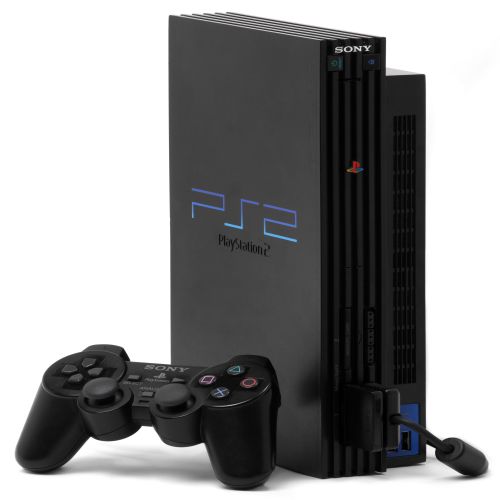 Three of the original PS2 launch models (SCPH-10000, SCPH-15000, and SCPH-18000) were only sold in Japan, and lacked the expansion bay of current PS2 models. These models included a PCMCIA slot instead of the expansion bay port of newer models. SCPH-10000 and SCPH-15000 did not have built-in DVD movie playback and instead relied on encrypted playback software that was copied to a memory card from an included CD-ROM. (Normally, the PS2 will only execute encrypted software from its memory card, but see PS2 Independence Exploit.) V3 had a substantially different internal structure from the subsequent revisions, featuring several interconnected printed circuit boards. As of V4 everything was unified into one board, except the power supply. V5 introduced minor internal changes, and the only difference between V6 (sometimes called V5.1) and V5 is the orientation of the Power/Reset switch board connector, which was reversed to prevent the use of no-solder modchips. V7 and V8 included only minor revisions to V6. The PS2 standard color is matte black. Several different variations in color have been produced in different quantities and regions, including ceramic white, light yellow, metallic blue (aqua), metallic silver, navy (star blue), opaque blue (astral blue), opaque black (midnight black), pearl white, Sakura purple, satin gold, satin silver, snow white, super red, transparent blue (ocean blue), and also Limited Edition color Pink, which was distributed in some regions such as Oceania, and parts of Asia. The small PlayStation logo on the front of the disc tray could be rotated ninety degrees, in order for the logo to be the right way up in both vertical and horizontal console orientations. This feature is also used in the slimlines. SLIMLINE: Original style PS2 slimline with a DualShock 2 controller. This was superseded by another slimline design in 2007. 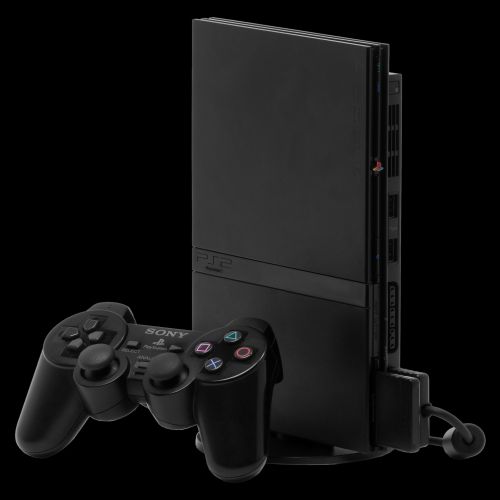 In September 2004, Sony unveiled its third major hardware revision (V12, model number SCPH-70000). Available in late October 2004, it is smaller, thinner, and quieter than the older versions and includes a built-in Ethernet port (in some markets it also has an integrated modem). Due to its thinner profile, it does not contain the 3.5" expansion bay and therefore does not support the internal hard disk drive. It also lacks an internal power supply, similar to the GameCube, and has a modified Multitap expansion. The removal of the expansion bay has been criticized as a limitation due to the existence of titles such as Final Fantasy XI, which require the use of the HDD. The official PS2 Linux also requires an expansion bay to function. Currently only the modified Multitap is sold in stores, however these are also compatible with the older versions, and also added support for multiple memory cards on some games. Third-party connectors can be soldered into the unit giving hard drive support, however IDE connections were completely removed in the V14 revision, thereby eliminating this option. Certain mod chips enable the use of a USB hard drive or other mass storage device. There are actually two sub-versions of the SCPH-70000.[citation needed] One of them includes the old EE and GS chips, and the other contains the newer unified EE+GS chip, but otherwise they are identical. The variations are variously referred to as V11.5 for the older model (with separate EE and GS chips) and V12 for the newer model, and V12 for the older model and V13 for the newer model.[citation needed] Currently, most people use V12 for both models, or V12 for the old model and V13 for the newer one. The V12 model was first released in black, but a silver edition is available in the United Kingdom, Germany, Australia, United Arab Emirates and other GCC Countries, France, Italy, South Africa, and most recently, North America. It is unknown whether or not this will follow the color schemes of the older model, although a limited edition console that is pink in color has become available since March 2007. V12 (or V13) was succeeded by V14 (SCPH-75001 and SCPH-75002), which contains integrated EE and GS chips, and different ASICs compared to previous revisions, with some chips having a copyright date of 2005, compared to 2000 or 2001 for earlier models. It also has a different lens and some compatibility issues with a different number of PlayStation games and even some PS2 games.[23] In the beginning of 2005 it was found that some black slimline console power transformers manufactured between August and December 2004 were defective and could overheat. The units were recalled by Sony, with the company supplying a replacement model made in 2005. Later hardware revisions had better compatibility with PlayStation games (Metal Gear Solid: VR Missions operates on most silver models); however, the new Japanese slim models have more issues with playing PlayStation games than the first PS2 revisions. In 2006, Sony released new hardware revisions (V15, model numbers SCPH-77001a and SCPH-77001b). It was first released in Japan on September 15, 2006, including the Silver edition. After its release in Japan, it was then released in North America, Europe and other parts of the world. The new revision uses an integrated, unified EE+GS chip, a redesigned ASIC, a different laser lens, an updated BIOS, and updated drivers.[citation needed] In July 2007, Sony started shipping a revision of the slimline PlayStation 2 (SCPH-79000) featuring a reduced weight of 600 grams compared to 900 grams of the SCPH-77001 (with Expansion Bay), achieved through a reduction in parts. The unit also uses a smaller motherboard as well as a custom ASIC which houses the Emotion Engine, Graphics Synthesizer, and the RDRAM. The AC adaptor's weight was also reduced to 250 grams from the 350 grams in the previous revision. Another refinement of the slimline PlayStation 2 (SCPH-90000) was released in Japan on November 22, 2007,[26] As well some cosmetic changes, the design of the hardware has been overhauled, incorporating the power supply into the console itself; this also reduces the total weight to 720 grams (25 oz). SCPH-90000 series consoles manufactured after the third quarter of 2008 (indicated by date code 8C) incorporate a revised BIOS, which disables an exploit present in all older models that allowed homebrew applications to be launched from a memory card. E - SALES: Japan 21 million (as of October 1, 2008) Asia (including Japan) 25.42 million (as of March 2007) North America 50 million (as of December 2008) Europe 48 million (as of May 6, 2008) Worldwide 153.19 million (as of March 31, 2011) On November 29, 2005, the PlayStation 2 became the fastest game console to reach 100 million units shipped, accomplishing the feat within 5 years and 9 months from its launch. This achievement occurred faster than its predecessor, the PlayStation, which took 9 years and 6 months to reach the same benchmark. The PS2 has sold 150 million units worldwide as of January 31, 2011. In Europe, it has sold 48 million units as of May 6, 2008 according to Sony Computer Entertainment Europe, while in North America, it has sold 50 million units as of December 2008. In Japan, the PS2 has sold 21,454,325 units as of October 1, 2008, according to Famitsu/Enterbrain. In Europe, the PS2 sold 6 million units in 2006 and 3.8 million in 2007, according to estimates by EA. In 2007, the PS2 sold 3.97 million units in the US according to the NPD Group and 816,419 units in Japan according to Enterbrain. In 2008, the PS2 sold 480,664 units in Japan, according to Enterbrain. F - ACCESORIES: The PlayStation 2's DualShock 2 controller is largely identical to the PlayStation's DualShock, with the same basic functionality; however, it includes analog pressure sensitivity on the face, shoulder and D-pad buttons, is lighter and includes two more levels of vibration. Optional hardware includes DualShock or DualShock 2 controllers, a PS2 DVD remote control, an internal or external hard disk drive (HDD), a network adapter, horizontal and vertical stands, PlayStation or PS2 memory cards, light guns (GunCon), fishing rod and reel controllers. Also available are various cables and interconnects, including the Multitap for PlayStation or PS2, S-Video, RGB, SCART, VGA (for progressive scan games and PS2 Linux only), component and composite video cables, an RF modulator, a USB camera (EyeToy), dance pads for Dance Dance Revolution, In the Groove, and Pump It Up titles, Konami microphones for use with the Karaoke Revolution games, dual microphones (sold with and used exclusively for SingStar games), various "guitar" controllers (for the Guitar Freaks series and Guitar Hero series), the drum set controller (sold in a box set (or by itself) with a "guitar" controller and a USB microphone (for use with Rock Band and Guitar Hero series(World Tour and newer)), Onimusha 3 katana controller, Resident Evil 4 chainsaw controller, a USB keyboard and mouse, and a headset. Early versions of the PS2 could be networked via an iLink port, though this had little game support and was dropped. The original PS2 multitap cannot be plugged into the newer slim models (as the multitap connects to the memory card slot as well as the controller slot and the memory card slot on the slimline is shallower). New slim-design multitaps are manufactured for these models, however third-party adapters also exist to permit original multitaps to be used. Some third party manufacturers have created devices that allow disabled people to access the PS2 through ordinary switches etc. One such device is the PS2-SAP from LEPMIS, another is for example the JPemulator. MOUSE FUNCTION: Unlike the PlayStation, which required the use of an official Sony PlayStation Mouse to play mouse-compatible games, the few PS2 games with mouse support work with a standard USB mouse as well as a USB Trackball. USB Mouse compatible games – Age of Empires II, Armored Core 2, Armored Core 3, ATV Quad Power Racing 2, Deus Ex, Dirge of Cerberus: Final Fantasy VII, EverQuest Online Adventures: Frontiers, Final Fantasy XI, Half-Life (video game), Myst III: Exile, Red Faction 2, Resident Evil 4, Sky Odyssey, Soldier of Fortune: Gold Edition, Star Trek Elite Force, Tokyo Xtreme Racer 3, Unreal Tournament. The official PS2 Linux kit also uses the USB mouse and keyboard. Additionally, a mouse that emulates the right analog stick of a standard controller, the EdgeFX, was manufactured by SplitFish, allowing non-mouse-compatible games to be played with a mouse. G - TECHNICAL SPECIFICATIONS: The specifications of the PlayStation 2 console are as follows, with hardware revisions: 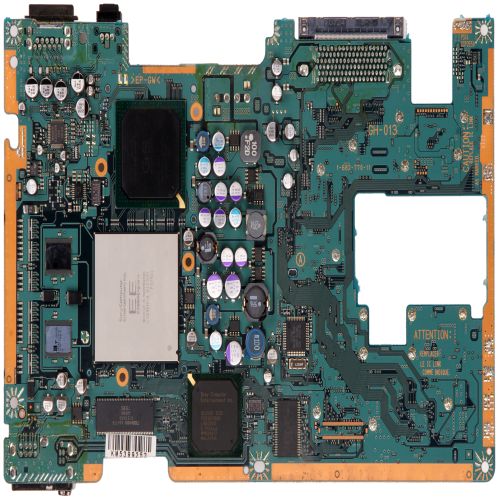 An SCPH-30001 motherboard 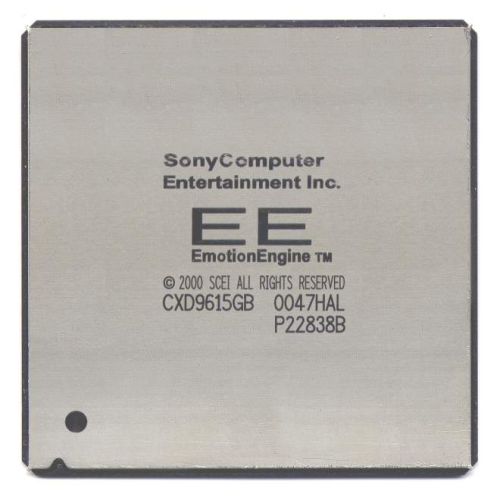 Emotion Engine CPU 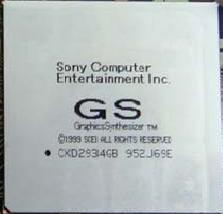 Graphics Synthesizer GPU 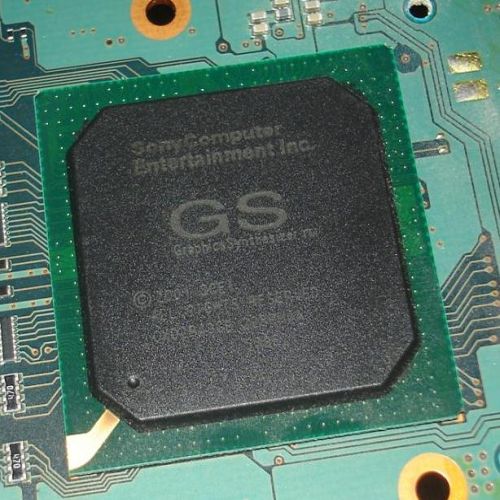 Graphics Synthesizer as on SCPH39000. 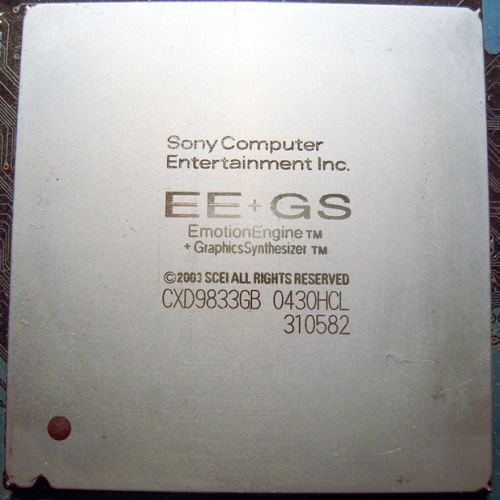 Older EE+GS that does not incorporate system memory (Found in Older Charcoal Black Slim PS2s. (SCPH-70001). 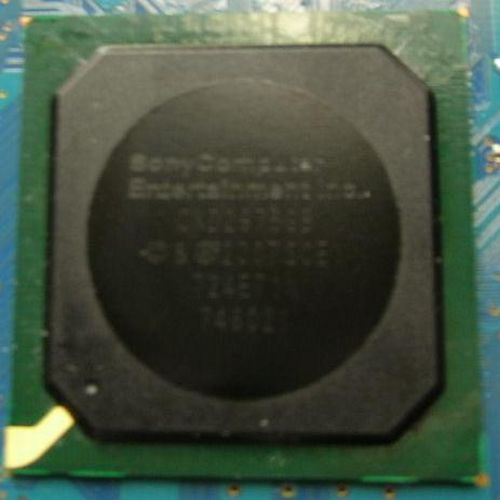 ASIC that incorporates the EE, GS, and system memory (found in silver slim PS2s. Model SCPH-7900x and later). - CPU: 64-bit "Emotion Engine" clocked at 294.912 MHz (299 MHz on newer versions), 10.5 million transistors - System memory: 32 MB Direct Rambus or RDRAM - Memory bus Bandwidth: 3.2 gigabytes per second - Main processor: MIPS R5900 CPU core, 64-bit, little endian (mipsel). - Coprocessor: FPU (Floating Point Multiply Accumulator × 1, Floating Point Divider × 1) - Vector Units: VU0 and VU1 (Floating Point Multiply Accumulator × 9, Floating Point Divider × 1), 32-bit, at 150 MHz. - VU0 typically used for polygon transformations optionally (under parallel or serial connection), physics and other gameplay based things - VU1 typically used for polygon transformations, lighting and other visual based calculations (Texture matrix able for 2 coordinates (UV/ST) - Parallel: Results of VU0/FPU sent as another display list via MFIFO (E.G. complex characters/vehichles/etc.) - Serial: Results of VU0/FPU sent to VU1 (via 3 methods) and can act as an optional geometry pre-processor that does all base work to update the scene every frame (E.G. camera, perspective, boning and laws of movement such as animations or physics) - Floating Point Performance: 6.2 gigaFLOPS (single precision 32-bit floating point) - FPU 0.64 gigaFLOPS - VU0 2.44 gigaFLOPS - VU1 3.08 gigaFLOPS (with Internal 0.64 gigaFLOPS EFU) - Tri-Strip Geometric transformation (VU0+VU1): 150 million polygons per second - 3D CG Geometric transformation with raw 3D perspective operations (VU0+VU1): 66-80+ million polygons per second - 3D CG Geometric transformations at peak bones/movements/effects (textures)/lights (VU0+VU1, parallel or series): 15–20 million polygons per second[49] - Actual real-world polygons (per frame):500-650k at 30fps, 250-325k at 60fps - Compressed Image Decoder: MPEG-2 - I/O Processor interconnection: Remote Procedure Call over a serial link, DMA controller for bulk transfer - Cache memory: Instruction: 16 KB, Data: 8 KB + 16 KB (ScrP) - Graphics processing unit: "Graphics Synthesizer" clocked at 147 MHz - Pixel pipelines: 16 - Video output resolution: variable from 256x224 to 1280x1024 pixels - 4 MB Embedded DRAM video memory bandwidth at 48 gigabytes per second (main system 32 MB can be dedicated into VRAM for off-screen materials) - Texture buffer bandwidth: 9.6 GB/s - Frame buffer bandwidth: 38.4 GB/s - DRAM Bus width: 2560-bit (composed of three independent buses: 1024-bit write, 1024-bit read, 512-bit read/write) - Pixel configuration: RGB: Alpha:Z Buffer (24:8, 15:1 for RGB, 16, 24, or 32-bit Z buffer) - Dedicated connection to: Main CPU and VU1 - Overall pixel fillrate: 16x147 = 2.352 Gpixel/s (rounded to 2.4 Gpixel/s) - Pixel fillrate: with no texture, flat shaded 2.4 (75,000,000 32pixel raster triangles) - Pixel fillrate: with 1 full texture (Diffuse Map), Gouraud shaded 1.2 (37,750,000 32-bit pixel raster triangles) - Pixel fillrate: with 2 full textures (Diffuse map + specular or alpha or other), Gouraud shaded 0.6 (18,750,000 32-bit pixel raster triangles) - GS effects: AAx2 (poly sorting required),[47] Bilinear, Trilinear, Multi-pass, Palletizing (4-bit = 6:1 ratio, 8-bit = 3:1) - Multi-pass rendering ability - Four passes = 300 Mpixel/s (300 Mpixels/s divided by 32 pixels = 9,375,000 triangles/s lost every four passes) - Audio: "SPU1+SPU2" (SPU1 is actually the CPU clocked at 8 MHz) - Sound Memory: 2 MB - Number of voices: 48 hardware channels of ADPCM on SPU2 plus software-mixed channels - Sampling Frequency: 44.1 kHz or 48 kHz (selectable) - Output: Dolby Digital 5.1 Surround sound, DTS (Full motion video only), later games achieved analog 5.1 surround during gameplay through Dolby Pro Logic II - I/O Processor - I/O Memory: 2 MB - CPU Core: Original PlayStation CPU (MIPS R3000A clocked at 33.8688 MHz or 37.5 MHz) - Automatically underclocked to 33.8688 MHz to achieve hardware backwards compatibility with original PlayStation format games. - Sub Bus: 32-bit - Connection to: SPU and CD/DVD controller. - Connectivity: - 2 proprietary PlayStation controller ports (250 kHz clock for PS1 and 500 kHz for PS2 controllers) - 2 proprietary Memory Card slots using MagicGate encryption (250 kHz for PS1 cards, up to 2 MHz for PS2 cards) - 2 USB 1.1 ports with an OHCI-compatible controller - AV Multi Out (Composite video, S-Video, RGsB (SCART and VGA connector†), YPBPR(component)) - S/PDIF Digital Out - Expansion Bay for 3.5" HDD (Network Adaptor required, SCPH-10xxx to 5xxxx only) - Ethernet port (Slim only) - PCMCIA for PCMCIA Network Adaptor and External Hard Disk Drive (early models only) - FireWire (SCPH-10xxx to 3xxxx only) - Infrared remote control port (SCPH-5000x and newer) - VGA connector is only available for progressive-scan supporting games and Linux for PlayStation 2 and requires a monitor that supports RGsB, or "sync on green", signals. - Disc Drive type: proprietary interface through a custom micro-controller + DSP chip. 24x speed CD-ROM, 4x speed DVD-ROM — Region-locked with anti-copy protection. Can't read Gold Discs. - Supported Disc Media: PlayStation 2 format CD-ROM, PlayStation format CD-ROM, CD-DA, PlayStation 2 format DVD-ROM, DVD Video. DVD5 (Single-layer, 4.7 GB) and DVD9 (Dual-layer, 8.5 GB) supported. Later models starting with SCPH-50000 are DVD+RW and DVD-RW compatible. |